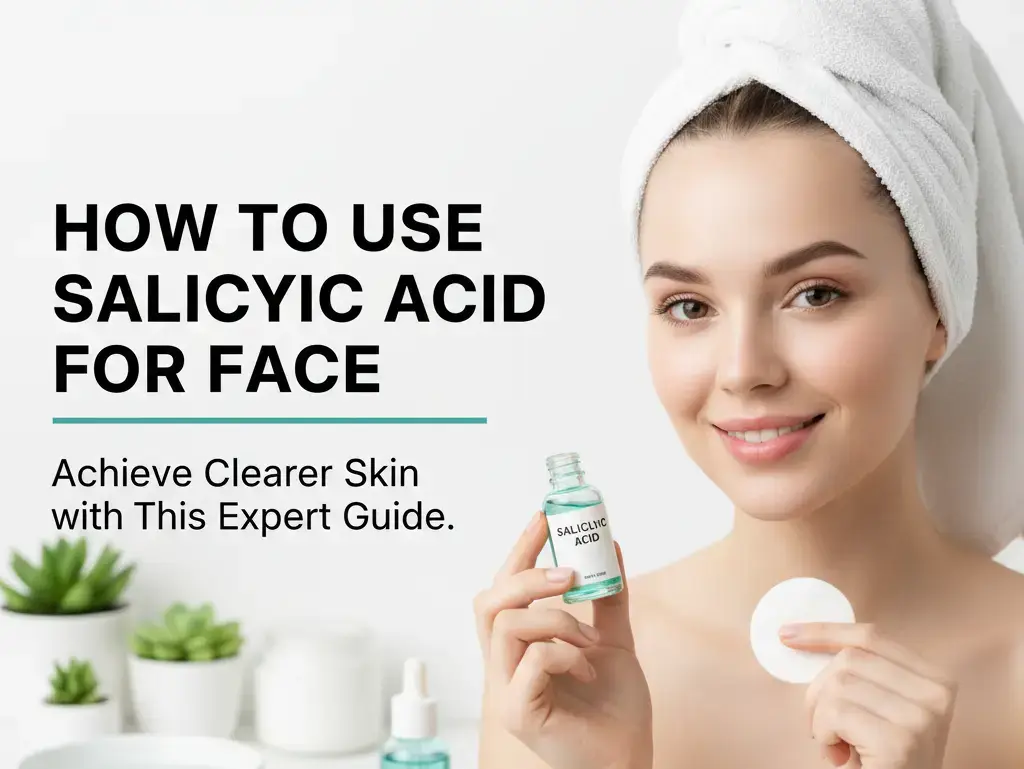Are you struggling with acne, blackheads, or uneven skin tone? Salicylic acid for face might be the simple solution your skincare routine needs.

This powerful yet gentle ingredient clears pores, reduces breakouts, and makes skin smoother without harsh scrubbing. In this guide, we’ll explain salicylic acid benefits, how to use it safely, and what to watch out for.
What is Salicylic Acid?
Salicylic acid is a beta-hydroxy acid (BHA) that comes from willow bark. Unlike water-based acids, it is oil-soluble, which means it goes deep into your pores to clean out oil and dead skin.
That’s why salicylic acid is perfect for people with oily or acne-prone skin.
You’ll find it in many skincare products like face wash, serum, or creams. Strengths range from 0.5% for beginners to 2% for stronger treatments. Always start with a lower percentage to avoid irritation.
Benefits of Salicylic Acid for Face & Skin
Here are the top benefits of using salicylic acid on skin:
1. Clears Acne and Breakouts
It cleans inside pores, reducing pimples, blackheads, and whiteheads. Most people see results in 4–6 weeks.
2. Gentle Exfoliation
Removes dead skin cells, giving smoother and brighter skin without the harshness of scrubs.
3. Controls Oil and Shine
Balances oil production, keeping your T-zone less greasy.
4. Fades Dark Spots
Helps lighten post-acne marks and mild pigmentation by removing dark skin cells.
5. Reduces Redness and Swelling
Works like a gentle anti-inflammatory, calming irritation from acne or rosacea.
6. Slows Signs of Aging
Boosts skin renewal, reducing fine lines and making skin firmer over time.
Best for oily, combination, or acne-prone skin. If you have dry or sensitive skin, always do a patch test first.
How to Use Salicylic Acid for Face & Skin (Step by Step)
Follow these steps to safely add salicylic acid to your routine:

Step 1: Cleanse
Use a salicylic acid face wash (0.5–1%) in the evening. Massage gently for 30–60 seconds, then rinse.
Step 2: Treat
Apply a salicylic acid serum (1–2%) to problem areas. Let it absorb for 1–2 minutes.
Step 3: Moisturize
Use a lightweight moisturizer with ceramides or hyaluronic acid to avoid dryness.
Step 4: Protect
In the morning, always apply SPF 30+ sunscreen because salicylic acid makes your skin more sensitive to the sun.
Pro Tip: Start using it 2–3 times a week, then increase to daily if your skin adjusts well.
Example Routine Table:
| Step | Product Type | Time of Day | Frequency |
|---|---|---|---|
| Cleanse | Salicylic Acid Face Wash | Evening | 2–3x per week |
| Treat | Salicylic Acid Serum | Evening | After cleansing |
| Moisturize | Lightweight Cream | AM & PM | Daily |
| Protect | Broad-Spectrum Sunscreen | Morning | Daily |
Avoid mixing with retinoids or benzoyl peroxide in the beginning to prevent irritation.
How to Choose the Best Salicylic Acid for Face
Not all products work the same. Keep these tips in mind:
- Strength: 0.5–1% for daily use, 2% for spot treatments.
- Form: Serums work fast, creams add hydration, and face washes are good for beginners.
- Extra Ingredients: Niacinamide (soothes redness) or tea tree (fights bacteria).
- Skin Type: Oily skin → gel-based. Sensitive skin → fragrance-free.
Popular choices include gentle options from CeraVe and The Ordinary.
Side Effects of Salicylic Acid for Face
Most people use salicylic acid safely, but some may face mild issues:
image
- Common: Dryness, redness, or mild stinging (goes away in 1–2 weeks).
- Rare: Peeling, itching, or hives—stop use and see a dermatologist.
- Sun Sensitivity: Can make your skin burn faster.
Prevention Tips:
- Always moisturize.
- Do a patch test before use.
- Don’t overapply.
- Pregnant or breastfeeding? Check with your doctor.
- Children under 12 should use only with medical advice.
Compared to benzoyl peroxide (kills acne bacteria) and glycolic acid (surface exfoliant), salicylic acid is gentler on pores but still powerful if used correctly.
Salicylic Acid Comparisons and Myths
- Vs. Benzoyl Peroxide: Salicylic unclogs pores, benzoyl kills acne bacteria. For stubborn acne, alternate them.
- Vs. Glycolic Acid: Salicylic is better for oily skin, glycolic for dry or dull skin. Use only one at first.
- Myth – It Thins Skin: Not true. When used properly, it actually strengthens skin over time.
Final Thoughts
Salicylic acid for face is one of the best skincare ingredients for clear, smooth, and healthy skin. Whether you choose a serum, cream, or face wash, it can help reduce acne, blackheads, and oil.
Start slow, use it the right way, and never forget sunscreen. With consistent use, you’ll enjoy the amazing benefits of salicylic acid.
FAQs About Salicylic Acid for Face
Q1. Can I use salicylic acid every day?
Yes, once your skin gets used to it. Start with a mild face wash.
Q2. Does salicylic acid lighten skin?
It helps fade dark spots. For better results, pair with vitamin C (use at different times).
Q3. Is it safe for sensitive skin?
Yes, but do a patch test and stick to low-strength products.
Q4. How long before I see results?
2–4 weeks for acne improvement, 6–8 weeks for fading marks.
Q5. Can salicylic acid help with keratosis pilaris (bumpy skin)?
Yes, it gently smooths rough, bumpy patches on the cheeks and arms.




